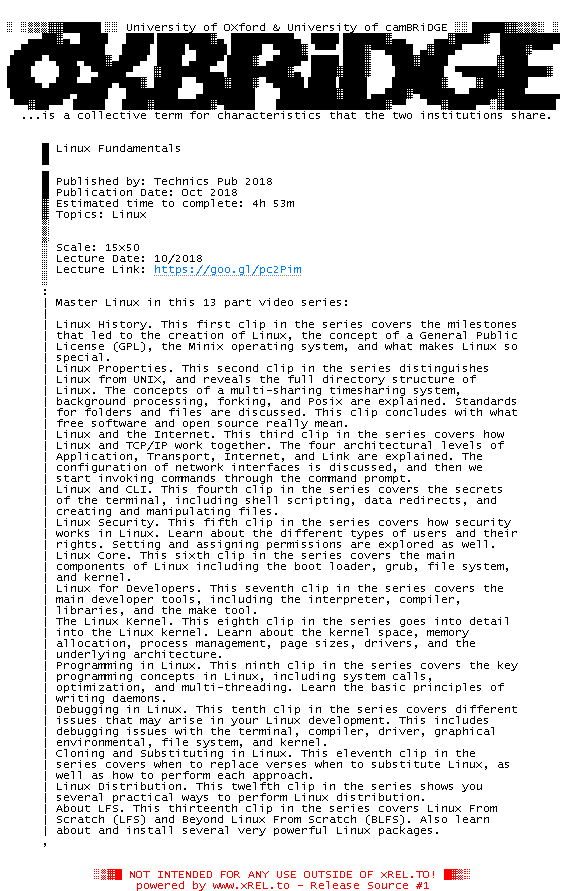
University of OXford & University of camBRiDGE
...is a collective term for characteristics that the two institutions share.
Linux Fundamentals
Published by: Technics Pub 2018
Publication Date: Oct 2018
Estimated time to complete: 4h 53m
Topics: Linux
Scale: 15x50
Lecture Date: 10/2018
Lecture Link: https://goo.gl/pc2Pim
| Master Linux in this 13 part video series:
| Linux History. This first clip in the series covers the milestones
| that led to the creation of Linux, the concept of a General Public
| License (GPL), the Minix operating system, and what makes Linux so
| special.
| Linux Properties. This second clip in the series distinguishes
| Linux from UNIX, and reveals the full directory structure of
| Linux. The concepts of a multi-sharing timesharing system,
| background processing, forking, and Posix are explained. Standards
| for folders and files are discussed. This clip concludes with what
| free software and open source really mean.
| Linux and the Internet. This third clip in the series covers how
| Linux and TCP/IP work together. The four architectural levels of
| Application, Transport, Internet, and Link are explained. The
| configuration of network interfaces is discussed, and then we
| start invoking commands through the command prompt.
| Linux and CLI. This fourth clip in the series covers the secrets
| of the terminal, including shell scripting, data redirects, and
| creating and manipulating files.
| Linux Security. This fifth clip in the series covers how security
| works in Linux. Learn about the different types of users and their
| rights. Setting and assigning permissions are explored as well.
| Linux Core. This sixth clip in the series covers the main
| components of Linux including the boot loader, grub, file system,
| and kernel.
| Linux for Developers. This seventh clip in the series covers the
| main developer tools, including the interpreter, compiler,
| libraries, and the make tool.
| The Linux Kernel. This eighth clip in the series goes into detail
| into the Linux kernel. Learn about the kernel space, memory
| allocation, process management, page sizes, drivers, and the
| underlying architecture.
| Programming in Linux. This ninth clip in the series covers the key
| programming concepts in Linux, including system calls,
| optimization, and multi-threading. Learn the basic principles of
| writing daemons.
| Debugging in Linux. This tenth clip in the series covers different
| issues that may arise in your Linux development. This includes
| debugging issues with the terminal, compiler, driver, graphical
| environmental, file system, and kernel.
| Cloning and Substituting in Linux. This eleventh clip in the
| series covers when to replace verses when to substitute Linux, as
| well as how to perform each approach.
| Linux Distribution. This twelfth clip in the series shows you
| several practical ways to perform Linux distribution.
| About LFS. This thirteenth clip in the series covers Linux From
| Scratch (LFS) and Beyond Linux From Scratch (BLFS). Also learn
| about and install several very powerful Linux packages.

![]() Registrierte Benutzer können Text-, Hintergrund- und ANSI-Art-Farbe individuell anpassen!
Registrierte Benutzer können Text-, Hintergrund- und ANSI-Art-Farbe individuell anpassen!